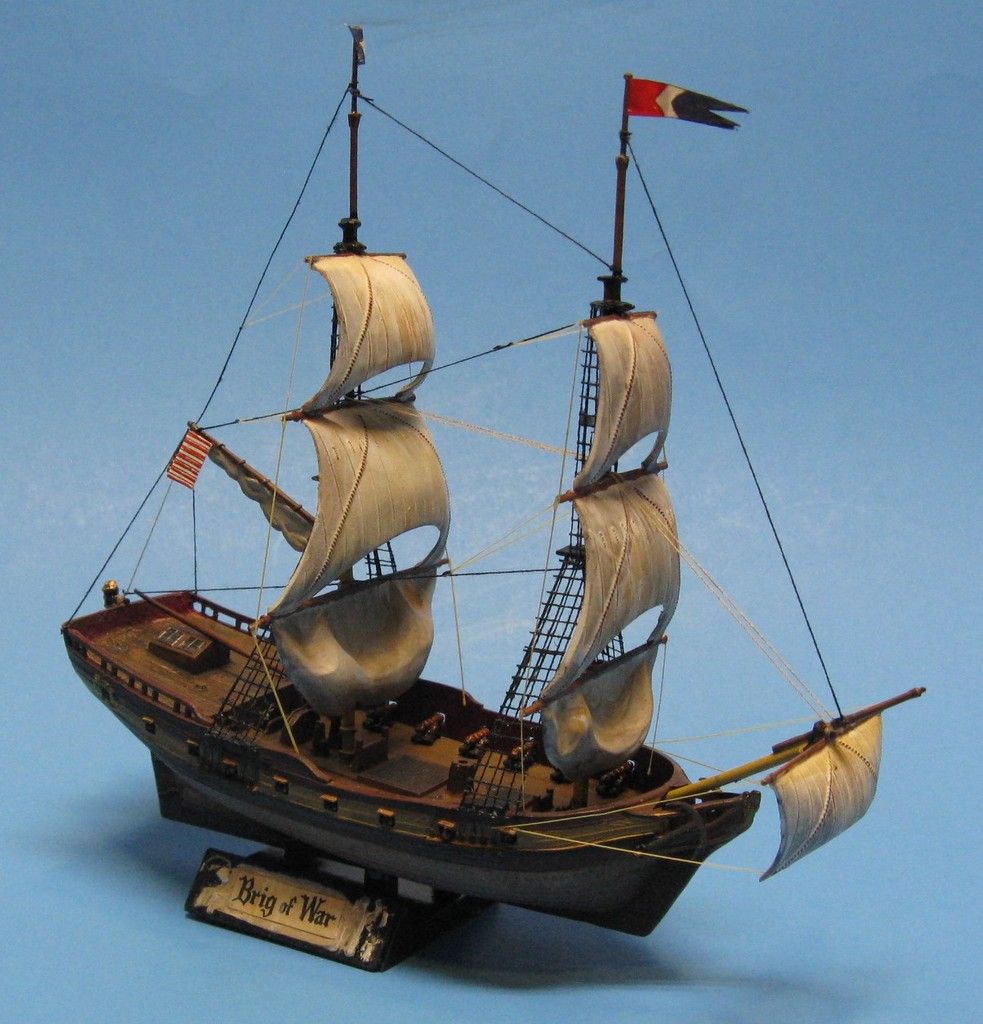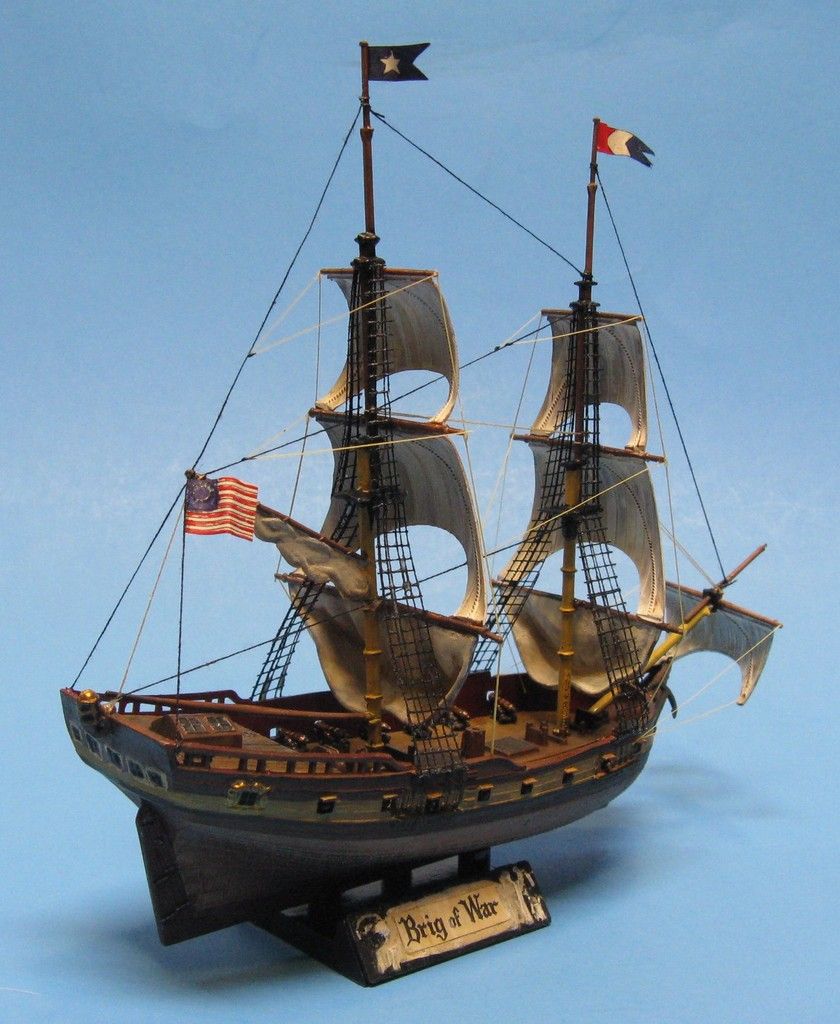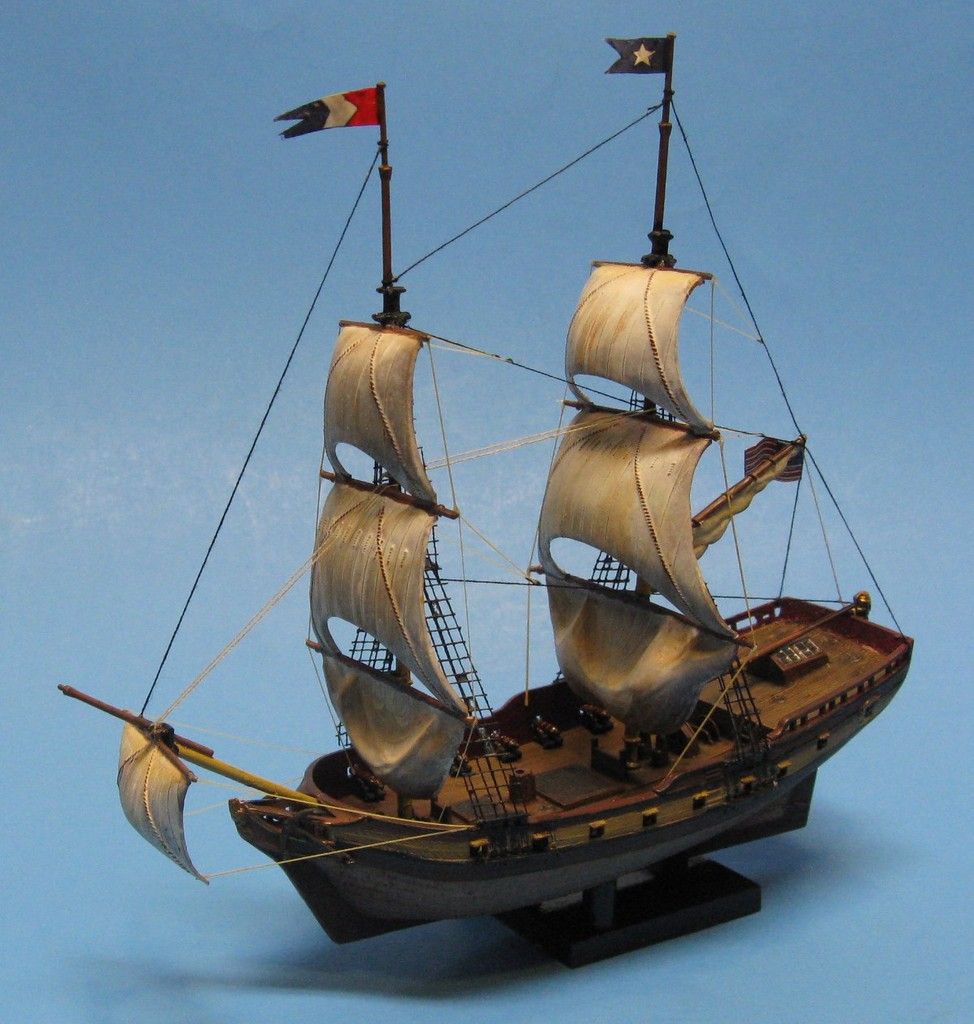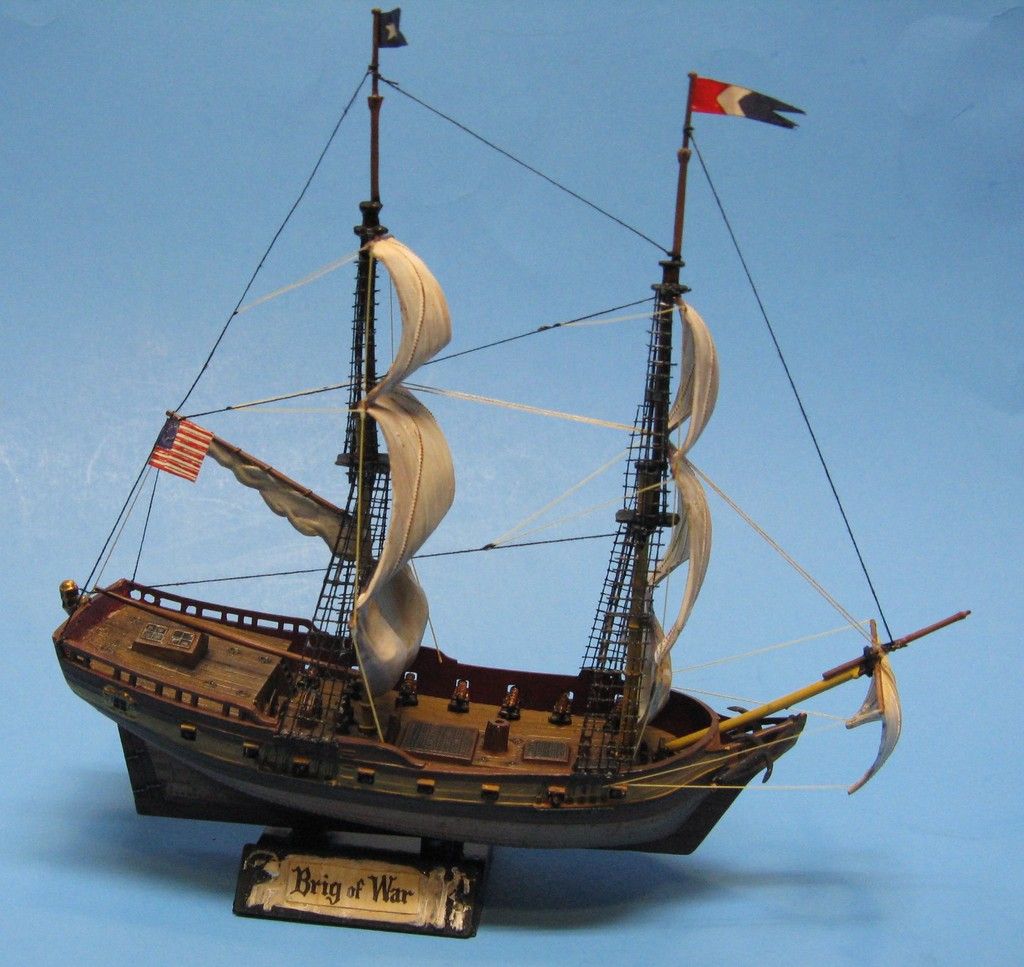This old kit is kind of a generic brig and seems a little tubby in shape. With that said, I always enjoy building these old kits of unusual subjects and trying to make them look as good as they can be.
Looks very nice for it’s age and a bit of fun thrown in…Cheers Mark
It’s a "Pyr"ate of the Model Shipways Fair American.
It’s a neat looking model.
Nice finish! You breathed life into that nostalgia kit.
I just discovered that this kit was, indeed, “borrowed” from the old Model Shipways “Fair American”. Very tempted to make this my next project. Very tempted.
Here’s a constructive “crit”. The locations of the yards are very odd, very low. I found a photo of the instruction sheet and the way this was built does match the instructions. The top gallant yard is shown attaching to the mast at the topmast crosstrees. And since the yards/ sails doohickey is a single part, that puts the main sail yard about halfway down the mast.
But…the illustration on the box shows otherwise; the yard for the course is right below the main top where it should be, the top sail yard further up the topmast, and on up.
If possible, if it were me, I’d try to break the things loose and raise them up a bunch.
Here’s a wack theory. The Fair American as represented by Model Shipways, has her sails missing. Therefore the yards are lowered. This model by contrast of course has her sails set. Maybe the copiers at Pyro followed the one, added sails and off to the races.
Looks great Rob. I might have to pick up one of these kits and give it a go.
Steve
This kit is available in a current Lindberg boxing. I built it years ago, and I have spied it on the shelves at HobbyTown. It sings a siren song to me, but so far I have resisted.
Does look way too wide at the beam. Cool nonetheless.
I remember building this kit and giving it to a girl when I was 17. She ended up becoming my wife.
I do have fond memories of this kit. It was the first sailing ship I had built (long before 17), and it inspired me to purchase the old Model Shipways solid hull Fair American kit (which I still have on the mantle in my den. Although the old Pyro kit, ne: Lindberg, seems a little beamy, the kit’s dimensions look close to the MS kit.
By the way, you did a nice job!
Bill
I was looking at this model and trying to think of what looked odd about it (nothing against this build, but the original kit). I found some drawings of the “Fair American”, started comparing, and found the problem.
The hull is in 1/170. The masts and sails are in 1/240.
By the way, this is my next project, pretty sure at this point…
That should be easy to correct. A few wooden dowels, a small lathe (or Dremel Moto-Tool), a little trial and error, tissue paper sails, and voila! A complete model in 1/170.
Like Mayflower, you did a beautiful job!
Happy Thanksgiving!
Bill Morrison
I see you’re on to me!
I am thinking that the kit’s mast and sails might work on the smaller Heller copy of this kit (“L’Orguellise”), which frees up those masts and sails for an even smaller model ad infinitum…
I built one of these ages ago, when quantity trumped quality. You have displayed great talent here, a splendid job. As far as the pointed out technical shape issues go, all I can say is beauty is in the eye of the beholder.
regards,
Jack
Just want to add a correction to my earlier measurements. The sails and yards are 1/240, the bowsprit a little short, and the mizzen booms also a bit small, but the masts are pretty close. Just compared them to better drawings.
- RL
My only suggestion is to set the yard for the course right up under the tops, then set the upper two yards lowered if no sails or raised if sails set. I’m not sure what the FA drawings show, but the model is usually built without sails. I really wish I still had mine.
You can read the instructions for the Model Shipways kit, complete with illustrations, on the web: http://www.modelexpo-online.com/images/docs/MS2015/MS2015-Fair_American-Instruction_Manual-Complete.pdf .
You can also buy the plans, but they aren’t exactly cheap: $50.00.
It’s to be remembered that the old Pyro kit is, as GM pointed out, a pirated, miniaturized version of an earlier, solid-hull version of the Model Shipways kit, which is, in turn, a model of a model. The whole sequence goes back to a contemporary (or near-contemporary) model of a brig in the U.S. Naval Academy Museum. That model has the name “Fair American” painted on the transom; that’s the only reason to attribute the name to an actual vessel. (The name was quite a common one in the late eighteenth and early nineteenth centuries.) Quite a few people have done research on that model over the years, but nobody has ever figured out exactly what vessel it represents or when it was built. As the instruction book indicates, the rigging contains some anachronisms (the dolphin striker, for instance) that don’t click with the guesstimated time period of the American Revolution - but there’s no way to tell how many times the model has been restored or altered. We don’t even know on what plan, if any, it was based. Even the scale of the old relic is a guess.
I’d have to compare the Pyro kit with the MS plans to be sure, but I’m inclined to agree with Mr. Helfrich: it does look like Pyro may have exaggerated the beam a little. It also looks to me like the quarterdeck may not have enough taper to it; the MS kit’s seems to be proportionally narrower at the transom. I don’t think the people responsible for designing those tiny sailing ship kits were particularly interested in making them look like real ships. (The Golden Hind, which I can remember building with great pleasure when I was in elementary school, has a hull form that’s pretty amusing.) I remember thinking of them as 50-cent kits that could be picked up at the drug store around the corner from our house. (For a dollar you could pick up the kit, a couple of bottles of Testor’s glossy paint, a camel hair brush, and a tube of glue, and have enough left over for a cherry phosphate at the soda fountain. I remember painting that Golden Hind overall with Testor’s gold. My parents thought it was beautiful - or, as my mother probably put it, “adorable.”)
GM is right about the locations of the yards: the person who drew the instructions told the modeler to mount them one “level” too low. The lower yards belong just a few scale feet below the tops. I can’t blame Mr. Helfrich if he leaves them as they are, though.
The idea of “re-scaling” the spar plan is interesting. I can’t see any rational reason to use the kit masts and yards at all, though. An hour’s work with some small dowels (or pieces of wire), and maybe some plastic sheet for the tops, would produce something considerably more realistic than Pyro’s nondescript shapes.
At any rate, it does have the potential to be turned into a nice little scale model - and given the history of the plans, nobody can really say how accurate it is.
Ironically, already busy working on a blog entry about the model. I reduced some old Italian plans for the “Fair American” to the same size as the model, and took pictures of the larger plastic pieces compared with them. In short, these are my findings -
Model is a bit too beamy, and it looks as though they simply made the model wider as they went astern. Transom is therefore twice as wide as it should be. Correcting this would be a bear.
Masts are close to scale, bowsprit perhaps 1/4" too short. However, they are flimsy, and as Prof. Tilley pointed out, not very detailed.
Yards and sails are really undersized.
If one was willing to just go the simple route and make properly sized yards and booms, that would be enough. The ship’s generous beam and overly so posterior wouldn’t distract too much… I think. But correcting all the problems would be a challenge.
This round, my attempt is to just address the masts, yards, and deck detail. Though that quarterdeck and transom nags me. Sadly, they just about got the model dead on in profile.
Cheers,
- Robert
I’ll just say this, that a 18th Century brig comes in about as many shapes as Chevrolets in the 1950’s, or well, women throughout time. (men too).
I think in this very nice little example of a massively produced, reasonably accurate compared to say most of the models sold as “Galleons”, a model that a good modeler can sit back and look at and say, if I were designing this how would I set up the spars? Truly a win-win.
I really wish I still had my forever unfinished FA. Given to me a little too young.
This is the little blog entry I hinted at in my previous comment. It is where I basically commit to this model as my next project. In this, I discuss the model’s shortcomings.
The Lindberg “Brig of War”, A Conundrum in Plastic
Still planning to keep the improvements simple for now. We’ll see what happens when I commence.
Cheers,
- Robert
Won mine over, we were on a trade trip to China in 1985 and her Nikon SLR stopped taking pictures. Did a field strip (the camera you idiot!) with locally procured parts and toothbrushes.




